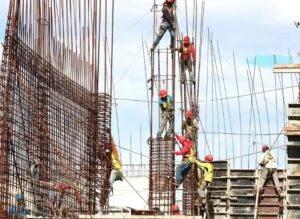According to Drilling Contractor.org, the United States has 645 active land-based oil rigs and 38 offshore oil rigs in operation. Most of those ocean oil rigs are operating in the Gulf of Mexico. Offshore drilling is expanding compared to land-based sites, according to the most recent market information.
For the people who live and work on oil rigs in the ocean, this information is important because of the profits and risks in offshore oil work. Oil rig workers face considerable danger but have opportunities for great returns when all goes well. What rights do offshore workers have when things go wrong?
Risks Faced by Workers
Offshore oil drilling is one of the most high-risk industries today, surpassed only by agriculture and logging in terms of preventable injuries and deaths. Why are oil rigs in the ocean more dangerous than other job locations? It has to do with the differences between the land and the sea. Ocean oil rig disasters have unique issues not present in land-based disasters.
- Transportation accidents. Offshore workers live and work on oil platforms for several days or weeks at a time. The usual means of transport is by helicopter. While helicopters are generally reliable, they have a higher accident rate than other modes of transportation.
- Exposure to harmful substances. The oil and gas industry pumps tens of thousands of gallons of crude oil and trillions of cubic yards of natural gas from the earth each day. When accidents occur, maritime workers are exposed to these and other possible toxins.
- Environmental hazards. The daily routine of an oil rig in any location is difficult. The work is taxing and involves handling heavy equipment in tight quarters. Now add high winds, high temperatures, waves smashing against the infrastructure, and a risk of falling overboard. Even in ordinary weather conditions, the environment is not friendly.
- Fires and explosions. In 1988, the North Sea oil and gas platform Piper Alpha suffered a catastrophic failure and exploded, eventually burning almost to the waterline. In 2010, the Deepwater Horizon mobile offshore drilling unit (MODU) caught fire and exploded after its blowout preventer failed and methane shot up the well pipe. Fires and explosions are among the biggest nightmares facing oil rig workers.
- Extreme weather conditions. Even if they are firmly anchored to the sea floor, oil platforms are threatened by extreme weather because of their high centers of gravity. MODUs and drillships are even more at risk since they rely upon anchors and cables to hold them steady. When a “storm of the century” hammered the MODU Ocean Ranger in 1982, a series of errors combined to tip the rig into the wind and capsize it. All 84 men died in the pounding waves before help could arrive. The Seacrest Drillship disaster in Thailand, caused by a major typhoon, led to the loss of 91 crew members and the ship itself.
The greatest risk in working on offshore oil platforms is the distance involved in rescue efforts. Falling from a land-based oil rig may result in terrible injuries. Falling from an offshore rig means entering the water, where a worker’s absence might not even be noticed. Fires and explosions are more difficult or impossible to escape, and bad weather becomes lethal.
Legal Framework for Workers’ Rights
Because of the unique risks and extreme hazards facing oil rig workers, the Occupational Safety and Health Administration (OSHA) has separate workplace safety standards for the oil and gas extraction industry. In addition, regional agencies have specific guidelines for their areas, such as the Gulf Coast states and the West Coast.
Essential Labor Laws
The Jones Act, also known as the Merchant Marine Act of 1920, gives “seamen” the right to sue their employer for job-related injuries. “Seamen” is a term of art and means anyone who works on a vessel for more than a certain percentage of time.
The Longshore and Harbor Workers’ Compensation Act (LHWCA) is a similar law that gives maritime workers who are not “seamen” the same rights. LHWCA applies to:
- Longshoremen and others who load and offload cargo
- Ship builders and repairers
- Drivers of trucks who take cargo away from ships
But not:
- Marina employees or administrators
- Recreational boat workers or builders
- Anyone who does not work “on or near” navigable water
The Outer Continental Shelf Lands Act (OCSLA) effectively extends the protections of the LHWCA as far out as the continental shelf — in other words, out to where oil rigs are based and anchored. The act’s purpose was to protect workers on fixed oil rigs, drilling platforms, and artificial islands engaged in exploring, developing, and producing natural resources from the seabed attached to the continental shelf. It does not include ships, which are covered by the Jones Act. The status of mobile platforms and drilling vessels depends on whether they are anchored or free-floating.
Federal Protections for Workers
In 2019, the Supreme Court held that federal law applies to all workers in regard to wages and other job protections. (Parker Drilling Management Services, Ltd. v. Newton 2019 slip op.) The Parker decision held that the federal Fair Labor Standards Act applied for purposes of overtime, standby pay, and other wage and hour laws. Unless a “void or gap” in federal regulation is filled by state law, federal law prevails under the OCSLA.
What this means in general is that the FLSA should preempt all other state wage and hour laws if there is a contract dispute. However, Parker was argued under California’s wage and hour laws. It has not been tested in other states.
Workplace Safety Regulations (OSHA)
Nearly all the workplace safety regulations OSHA prescribes for the oil industry apply to other industries as well. After all, safe walking surfaces, sturdy stairwells and railings, and personal protective equipment are necessary no matter where the workplace is located.
OSHA and the National Institute for Occupational Safety and Health (NIOSH) have assembled reports relating to specific hazards in the oil and natural gas industry. These are not regulations, but they are helpful for workers and managers. These fact sheets and reports should be reviewed regularly by oil field workers and others in the industry.
Employee Protections and Rights
Offshore oil rig workers have the same rights and protections as workers elsewhere. Merely being 50 or 60 miles off the coast does not change their status as U.S workers subject to state and federal law. Thanks to the protections granted by OSHA and the FLSA, oil rig workers are guaranteed the same legal rights as any other worker.
Right to a Safe Working Environment
Employees anywhere have the right to a safe working environment. Employers must provide the proper equipment, train on how to use it, and properly maintain and replace it.
Employees also have the right to refuse to work with unsafe equipment or in conditions they believe to be unsafe. Employers cannot force workers to continue to work with improper equipment or in conditions that may cause them harm.
Right to Report Safety Violations
Workers have the right to report any safety violations without fear of retaliation and to request an OSHA inspection if they believe one is warranted. OSHA whistleblower protections prevent employers from taking action against a worker for any work-related complaint. This includes threatening to deport a worker or report them to immigration officials for any complaint.
Workers who have immigration concerns should contact the National Labor Relations Board. The NLRB will not ask about your immigration status.
Right to Workers’ Compensation
Forty-nine of the 50 states require employers to carry workers’ compensation insurance. Texas is the single exception. However, any Texas employer working with the government must have workers’ compensation insurance for their employees. Statistics show that about two-thirds to three-quarters of Texas employers have workers’ compensation, even though there is no legal requirement.
In all other states, employers must have workers’ compensation coverage. Injured workers may also have the right to file a third-party lawsuit if other individuals or entities are responsible for their injuries.
Legal Recourse for Injured Workers: Seeking Legal Representation
The laws protecting offshore oil rig workers are complex and confusingly interrelated. How a claim is presented may depend on whether a MODU was anchored to the sea floor (and thus was a “platform”) or moving to a new location (and therefore a “vessel”). The LHWCA has specific guidelines on who is and is not a “maritime worker” based on job description and distance of employment from the water.
If you are injured while working on or near the ocean on an oil rig, you need an attorney well versed in maritime law. Your attorney must understand the intricacies of the Jones Act, the LHWCA, and the OCSLA, as well as state and federal wage and hour laws.
Oil rig workers facing injuries and legal claims need help from the attorneys at Morris & Dewett Injury Lawyers. We understand the tangle of federal and state regulations, and we will help you seek the compensation you deserve for your injuries. Contact us for a review of your case and more information.





